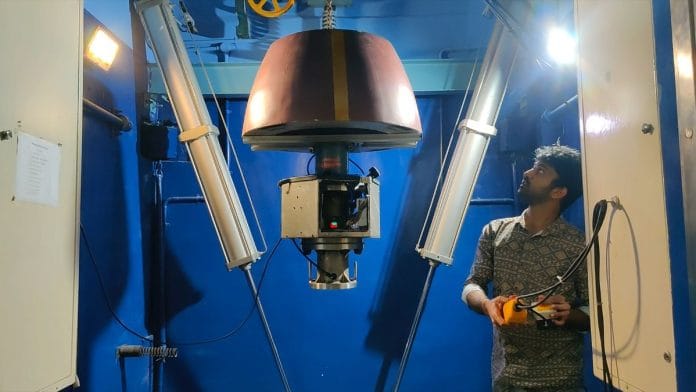Chennai: Every time Adhithya Sidharth starts his lab experiment at IIT Madras, he knows he is in an impossible race against time—two and a half seconds, to be precise. In the blink of an eye, he must determine whether all the permutations and combinations of his project will work in space.
“Our work runs parallel to ISRO’s Space 1.0 research. As ISRO works on Gaganyaan, we’re thinking about what we’ll do when the crew actually reaches space. While ISRO builds our Indian space station by 2040, we’re researching what India will work on in the space station,” said Sathyan Subbiah, the coordinator and founder of IIT Madras’ ExTeM centre.
His other post-doc colleagues can work in any campus lab and have their experiments run for hours on end. But Adhithya, who works at the ExTeM research centre in IIT Madras, is restricted by both time and space. After all, his projects can be tested only in a ‘drop tower’ with microgravity conditions to resemble outer space.
IIT Madras’ ExTeM or extraterrestrial manufacturing is pursuing research that is quite literally ‘out of this world’. It is looking at manufacturing in the cold, zero–gravity, near-vacuum environment of space—for products to be used both in space and also on Earth.
If we do end up going to space and having our own space stations, we shouldn’t be doing rudimentary experiments or relying on borrowed technology from other countries—we should have our indigenous ones.
Sathyan Subbiah, founder, ExTeM
The ExTeM team isn’t bothered with building the satellites and rockets that regularly grab national headlines and public attention. Instead, they are asking the question, “What will India do once it is actually in space?”
Working on what they call ‘Space 2.0 research’, ExTeM is made up of a group of interdisciplinary scientists developing indigenous technology to manufacture in space, build settlements using celestial material, and mend spaceships without returning to Earth. And India’s premier space institute, ISRO, is taking note.
“When we think of building on the Moon or Mars, we won’t be able to take everything we need from Earth to build there—it would just be too expensive and unviable,” said Subbiah. “So what you need to do is improvise based on the material already in space.”
Space welding, waterless concrete
Despite ExTeM’s futuristic and other-worldly perception, the team’s current projects are deceptively simple. For example, Adhithya is trying to figure out how welding works in microgravity. The process of melting and joining metal pieces together is crucial for manufacturing and construction, whether on Earth or in space. It is also the base for many 3D printing techniques globally used in space manufacturing. But its mechanics differ crucially without gravity.
“During the welding process, when metal melts on Earth, there is gravity to detach the droplets and deposit as weld bead,” Adhithya said, sitting in a first-floor lab in Chennai’s lush green IIT. “So, without gravity, how can we fuse metals together or 3D print something in space?”
Adhithya’s four-tiered experiment module is the answer. While the Soviets were welding in space in the 1970s through their cosmonauts, Adhithya had to rely on just 2.5-second-long slots of microgravity to figure out how welding occurs. And he found out how, in the absence of gravity, metal droplets melt and separate based on other physical forces like surface tension and plasma jets.
The lab, situated right next to the 38-metre-tall drop tower, is home to Adhithya’s cylindrical shelf-like experiment setup. This includes his welding and 3D printing machinery, data centres that record information, electrical sources that supply power, and most importantly, the camera that records the whole thing. The module, which is 1 metre tall, is then loaded into an air-tight capsule and then dropped from a height of 30 metres.
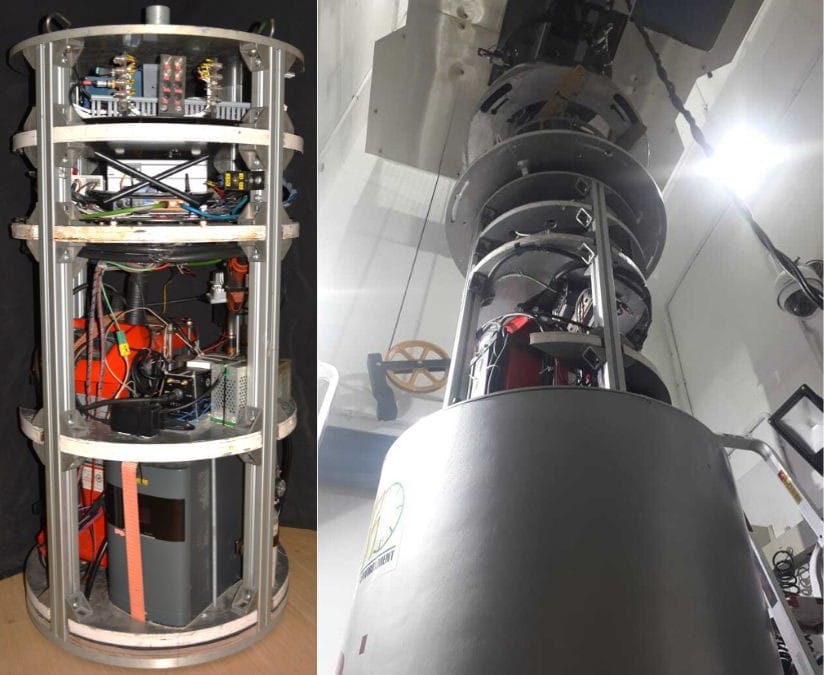
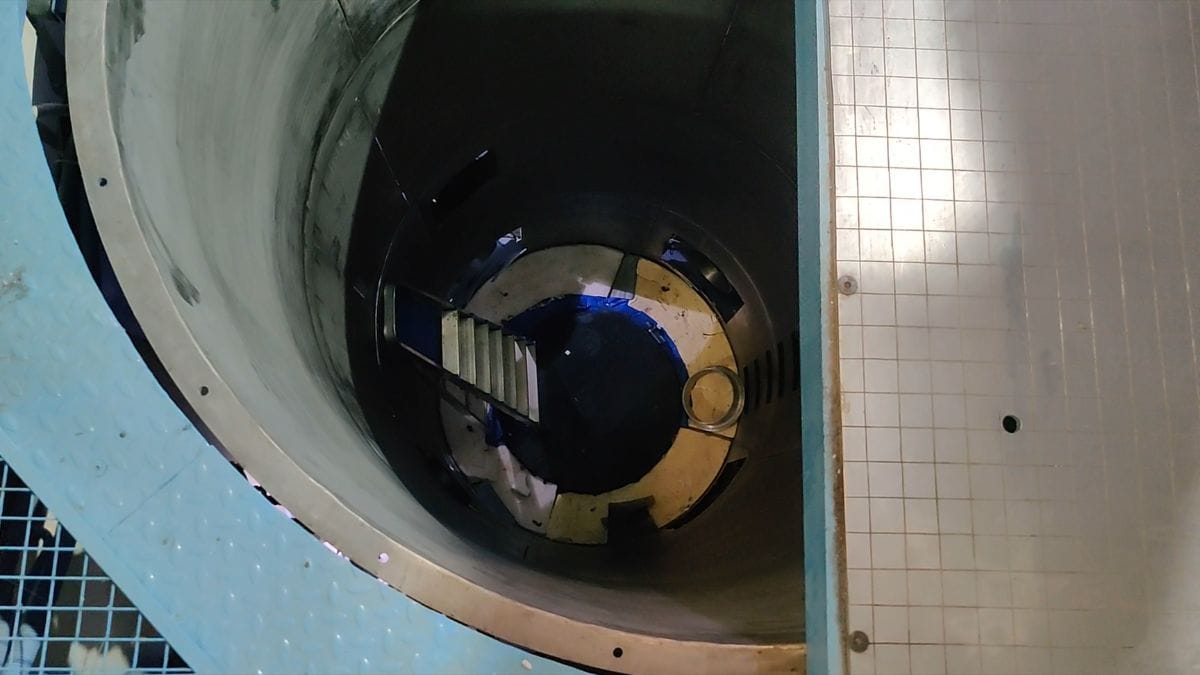
The setup yields a 3D-printed metal strip, barely the size of a finger. Yet, it confirms Adhithya’s hypothesis and brings him one step closer to building in space. All this becomes possible because of the microgravity tower in IITM.
“When any object falls—free falls—it experiences a short moment of weightlessness which is known as microgravity,” Subbiah explained. “It can’t be called pure microgravity, but it is the closest we can create here on Earth.”
IITM’s drop tower is the only microgravity simulator in the country and the fourth largest in the world. Its existence has led to other experiments in ExTeM too. Neelabh Menaria, a master’s student doing his thesis with the centre, is developing a functional way to make ‘metal foam’ in microgravity.
“As you can guess from the name, metal foams are a porous foam-like material made of metal,” Menaria said. “It is used in lightweight applications, which makes space manufacturing the perfect candidate for it.”
Menaria’s job is to understand how outer space would affect the foaming ability of metals. To do this conclusively in just 2.5 seconds, he has figured out a novel way. Holding up a rectangular case in his fingers, he shows how his setup allows for multiple rolls of metal to foam at the same time in the experiment, allowing him to compare their expansion sizes.
“Metal foams aren’t restricted to being used in spaceships and rockets; they can also be used to build in space. As a manufacturing material, it can help in building human settlements in space, and it can even protect against micrometeorites,” said Menaria.
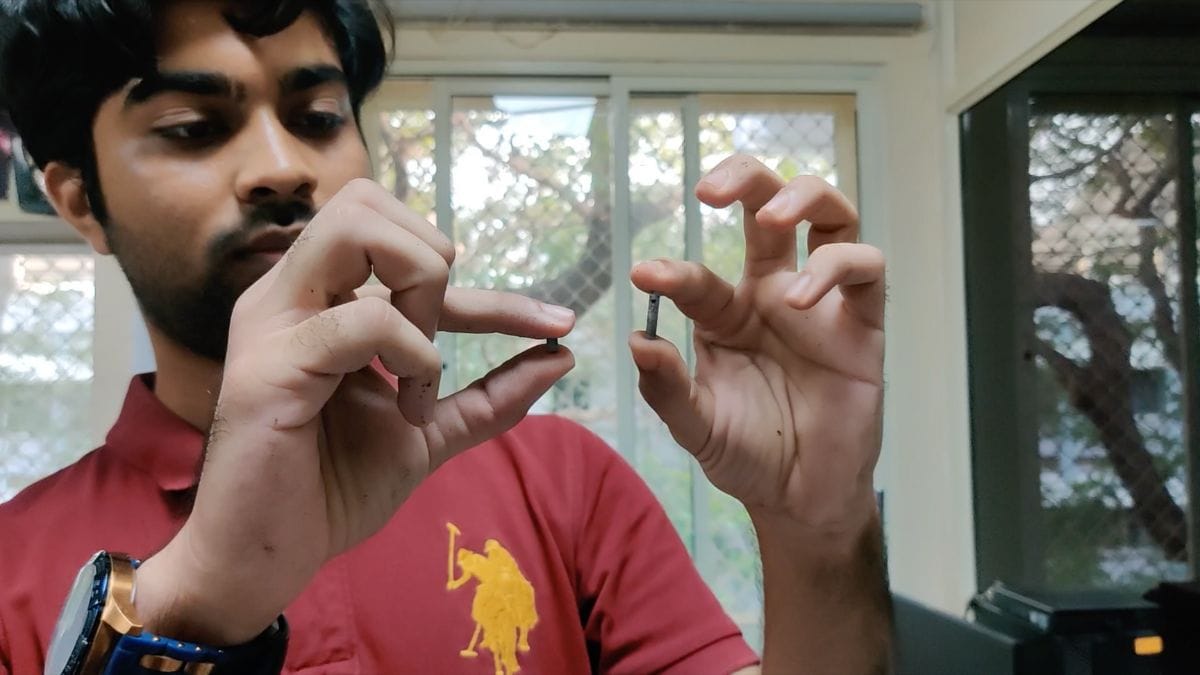
As Menaria works on creating metal foams for space construction, a professor at the centre is working on another crucial aspect of construction—concrete. Without the availability of water in space, the ability to make concrete, a key building material, is limited.
The only easily accessible material in this scenario is the soil or regolith on the Moon and Mars. Professor Piyush Chaunsali’s experiment was to mix sulfur with Martian regolith to make ‘water-less concrete’ in space. In the absence of actual regolith, the centre used a commercially available simulant of Martian soil.
Also read: India’s first crewed deep-sea mission set for testing—‘We’re to oceans what ISRO is to space’
History of the drop tower
In countries like the US and Russia (then the USSR), in-space manufacturing (ISM) began in the early 1970s as part of ‘microgravity physics’ studies. Aboard the Soyuz 6 rocket in 1969, Russia performed the first welding operations in microgravity, and the US soon followed with the Skylab mission in 1973.
By the early 2000s, the European Space Agency, Japanese Aerospace Exploration Agency, and even South Korea had started exploring microgravity and its various applications.
But India’s microgravity research, according to Subbiah, has been rather slow in comparison.
In 2018, ISRO asked private startups to pitch experiments in microgravity for their upcoming Gaganyaan Mission. In 2024, ISRO and the government’s Department of Biotechnology collaborated to further biotechnology research in microgravity. These are the first innings of India’s exploration of manufacturing and production in space, and ExTeM is a pioneer in the field.
We’ve submitted a few projects for the Gaganyaan Mission too, for them to carry as independent payloads. They’re yet to make their decision, but we have our priorities set. We’re working on other payload projects as well.
Adhithya Sidharth, ExTeM
It all began when Subbiah applied for IIT Madras’s Institute of Eminence grant in 2021 for ExTeM. India had by then already announced its ambitious space programme, which included sending humans to space by 2026 and sending a human to the Moon by 2040.
“But what will they do up there?” was the question ringing in Subbiah’s head. India desperately needed to catch up, said Subbiah, so that when it did reach space it was at par with other nations.
“If we do end up going to space and having our own space stations, we shouldn’t be doing rudimentary experiments or relying on borrowed technology from other countries—we should have our indigenous ones,” Subbiah added.
With this goal in mind, 14 professors from seven departments including mechanical engineering, civil engineering, aerospace engineering, and even biotechnology came together. With IIT Madras’ starter fund for an Institute of Eminence and access to microgravity, they opened India’s first research centre dedicated solely to Space 2.0 research.
The drop tower was at the core of their operations and experiments. A 38–metre–tall structure hidden inside a four-storey building, it was initially designed for combustion–related studies. Amit Kumar from the aerospace department, was one of the main figures batting for it in 2014, when India’s space programme was still nascent. He went on to become one of the founders of ExTeM.
“We knew the human space flight mission was coming, because ISRO was working on it, and then the need for a microgravity tower was imminent,” Kumar said. “Up until you’re sending inanimate objects to space, it is fine, but the second you send humans up there, you need to run scores of tests and check for every aspect of safety.”
Built in 2018, the drop tower is now housed at the National Centre for Combustion Research and Development (NCCRD) at IIT Madras, sharing its surroundings with deer that sometimes wander in from the nearby forest. Its importance in India’s space research cannot be overstated, with even some ISRO teams using the tower for their projects from time to time.
Also read: Uttarakhand’s ticking time bomb: Landslide lakes
Building in space for Earth
ExTeM’s work doesn’t just revolve around things that are difficult to build in space; their projects also tackle objects that are built objectively better in space than on Earth. From diamonds to optical fibres to even pharmaceutical drugs, microgravity conditions improve the manufacturing of certain products.
“For example, if we 3D printed a heart with minute details like arteries on Earth, it would collapse from its internal weight. In space, since there’s no weight without gravity, we could build a really specific, detailed 3D–printed heart,” said Adhithya. “Imagine the ramifications for the medical field!”
While 3D printing a heart in just 2.5 seconds is a distant dream, the Centre is working on another ISM project involving optical fibres. These are fibres about the size of a strand of hair, but their uses range from communication to defence to medicine to even space. They’re made in space using ZBLAN: an alloy of zirconium, barium, lanthanum, sodium, and aluminium fluorides.
“Experiments by NASA have shown that these fibres form better in microgravity where there is less crystallisation—they are cleaner with less impurities,” Adhithya explained.
Now, ExTeM has been recruited by a leading manufacturer in India to research optical fibre production for them. This is the first time India is investing in ZBLAN fibre research, which the US has been working on since the 1990s in the Marshall Space Flight Center. Through ExTeM, the Indian commercial sector is expanding its interest in space, and by way of that, ExTeM is expanding too.
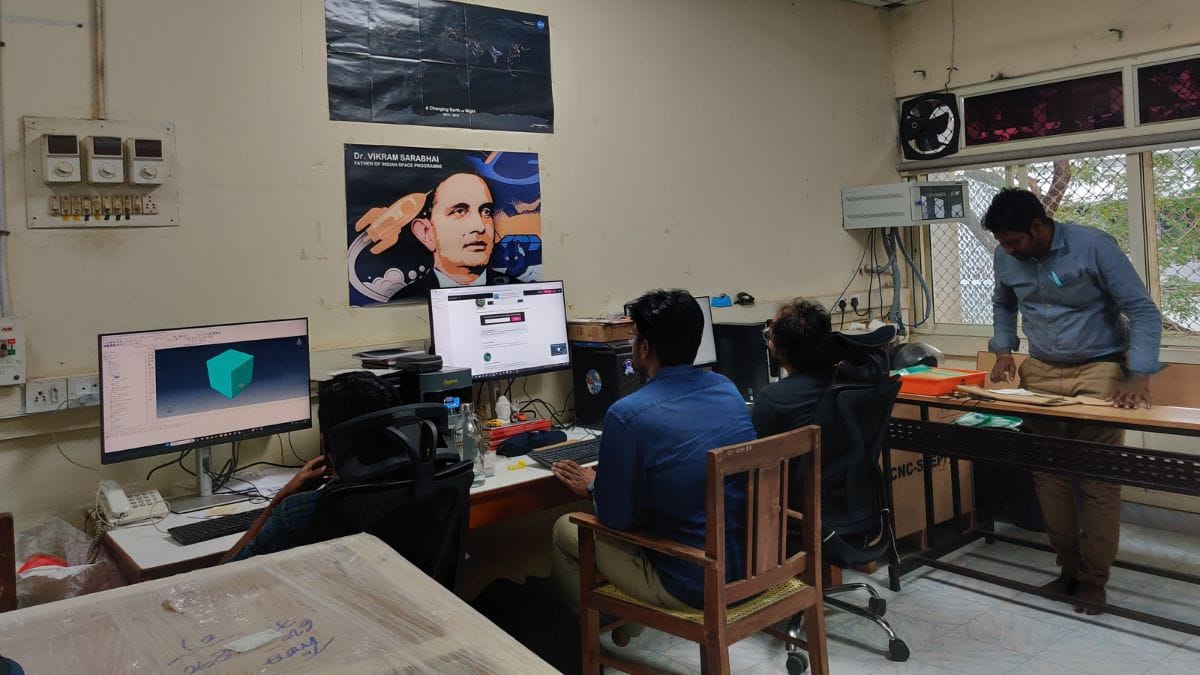
Next year, the manufacturer is sponsoring ExTeM’s research in a parabolic flight—another form of attaining microgravity that can last up to 20 seconds. Since 2.5 seconds of microgravity isn’t enough for optical fibre research, ExTeM is moving on to other methods.
“There are three ways you can achieve microgravity—one is obviously in space, through going the ISS [International Space Station]. That is too expensive and difficult for us. The other is on Earth using a drop tower, but it has time constraints,” said Subbiah. “Another method is a parabolic flight, which can give up to 20 seconds of microgravity and is less expensive than going to the ISS.”
A parabolic flight can be achieved through an aircraft that flies in the lower earth orbit (LEO) in multiple manoeouvres, making a U-shaped parabola to create the sense of weightlessness associated with microgravity. These parabolic manoeouvres result in 20-second periods of microgravity and in one flight, there can be up to 30 parabolas, yielding at least 10 minutes of microgravity.
Since the duration is much longer than a drop tower, it is perfect for ExTeM’s optical fibre research. Reflecting on this upcoming project, Subbiah said it is the natural course he imagined the centre to take.
“As the centre grows, so should our research. We need funds to run the show and at the end of the day, our research is only useful if it gets translated into commercial or government technology products,” he added.
Also read: ‘Noida Ek Tension’—Home buyers struggle for registry here, big players remain shy
Future plans
Two future concerns jostle for space in Adhithya’s mind when it comes to his work—one is India’s space future, which ExTeM is building. The other is ExTeM’s future, which, believe it or not, India is building.
Earlier in 2024, at the India Space Congress in New Delhi, the Chairman of ISRO, S Somanath, visited ExTeM’s booth. Since then, ExTeM has visited ISRO to discuss potential projects and received a positive response. Subbiah, too, is scheduling a meeting with them in Thiruvananthapuram.
The ExTeM team has presented their work everywhere from the Bengaluru Space Expo 2024 to the TechConnect World Innovation Conference in Washington DC.
“We’ve submitted a few projects for the Gaganyaan Mission too, for them to carry as independent payloads,” said Adhithya. “They’re yet to make their decision, but we have our priorities set. We’re working on other payload projects as well.”
Adhithya, who has been at the centre since it was started in 2021, remembers how initially they went in complemently blind. India had no history of microgravity research, never having sent an astronaut or conducted an experiment to the International Space Station. It was only through global research literature and ISRO’s latest work that ExTeM was even able to build a structure to guide its research.
Now though, the 30-member team regularly looks for opportunities that would take it beyond its comfort zone and closer to outer space. They’ve collaborated with international startups like Axiom Space, Space Foundry, and Vellon Space. They even have plans to submit a payload through ISRO’s POEM—PSLV orbital experiment module—that allows Indian startups to send experiments to Earth’s orbit and test in microgravity conditions.
Sitting at his workstation in the mechanical engineering department of IIT Madras, underneath a poster of Vikram Sarabhai, Adhithya explains how even industries seem to coming around to the idea of building in space.
“Of course, there is initial hesitation—people say it’s too futuristic from India’s perspective. But they also understand that if they miss this train now, in 20 to 30 years, when we’re actually in space, we will be too late in capitalising on it.”
(Edited by Prasanna Bachchhav)



